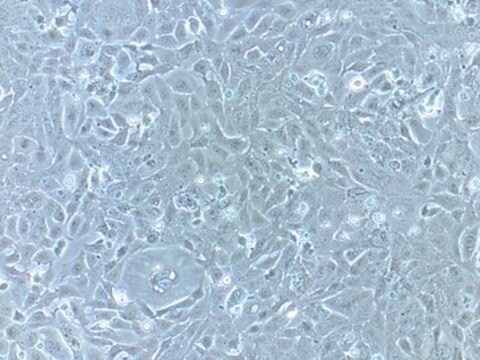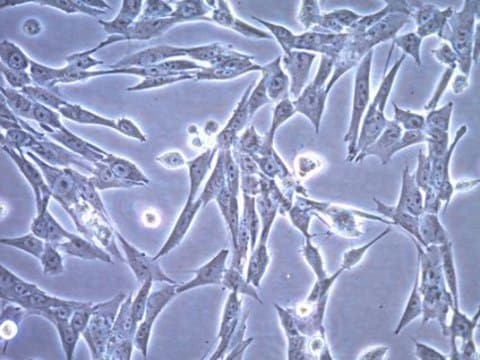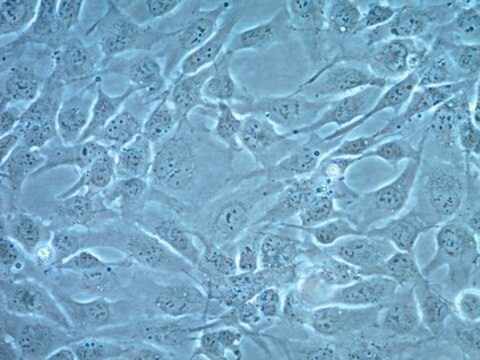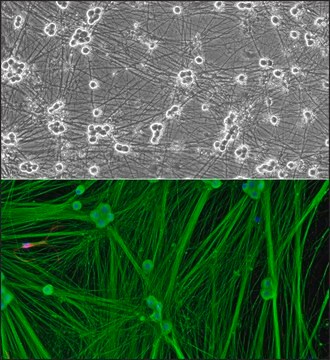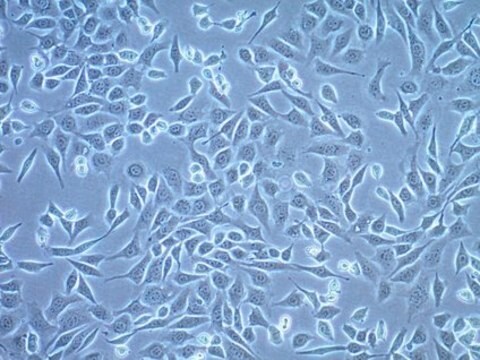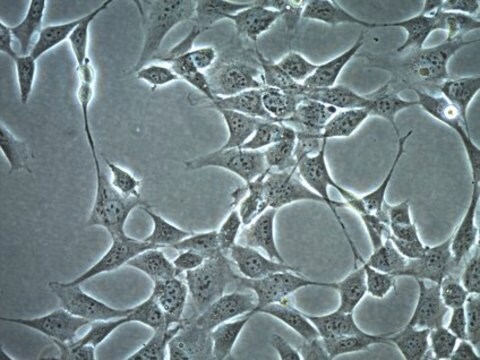推荐产品
产品名称
O9-1 Mouse Cranial Neural Crest Cell Line, stably expresses stem cell markers and neural crest markers
生物源
mouse
品質等級
技術
cell culture | stem cell: suitable
運輸包裝
liquid nitrogen
一般說明
Cranial neural crest cells give rise to ectomesenchymal derivatives such as cranial bones, cartilage, smooth muscle, dentin, as well as melanocytes, corneal endothelial cells, and neurons and glial cells of the peripheral nervous system. Previous studies have suggested that although multipotent stem-like cells may exist during the course of cranial neural crest development, they are transient, undergoing lineage restriction early in embryonic development.
Whole-genome expression profiling of O9-1 cells revealed that this line stably expresses stem cell markers (CD44, Sca-1, and Bmi1) and neural crest markers (AP-2a, Twist1, Sox9, Myc, Ets1, Dlx1, Dlx2, Crabp1, Epha2, and Itgb1). O9-1 cells are capable of contributing to cranial mesenchymal (osteoblast and smooth muscle) neural crest fates when injected into E13.5 mouse cranial tissue explants and chicken embryos. These results suggest that O9-1 cells represent multipotent mesenchymal cranial neural crest cells. The O9-1 cell line should serve as a useful tool for investigating the molecular properties of differentiating cranial neural crest cells. The O9-1 cell line can be propagated and passaged for at least 10 passages, and can differentiate into osteoblasts, chondrocytes, smooth muscle cells, and glial cells (Ishii, 2012).
Ishii, M., et al. (2012) A stable cranial neural crest cell line from mouse. Stem Cells Dev. 21(17): 3069-3080.
Whole-genome expression profiling of O9-1 cells revealed that this line stably expresses stem cell markers (CD44, Sca-1, and Bmi1) and neural crest markers (AP-2a, Twist1, Sox9, Myc, Ets1, Dlx1, Dlx2, Crabp1, Epha2, and Itgb1). O9-1 cells are capable of contributing to cranial mesenchymal (osteoblast and smooth muscle) neural crest fates when injected into E13.5 mouse cranial tissue explants and chicken embryos. These results suggest that O9-1 cells represent multipotent mesenchymal cranial neural crest cells. The O9-1 cell line should serve as a useful tool for investigating the molecular properties of differentiating cranial neural crest cells. The O9-1 cell line can be propagated and passaged for at least 10 passages, and can differentiate into osteoblasts, chondrocytes, smooth muscle cells, and glial cells (Ishii, 2012).
Ishii, M., et al. (2012) A stable cranial neural crest cell line from mouse. Stem Cells Dev. 21(17): 3069-3080.
細胞系描述
Neural Lineage Cells
應用
Research Category
Neuroscience
Stem Cell Research
Neuroscience
Stem Cell Research
This product is intended for sale and sold solely to academic institutions for internal academic research use per the terms of the “Academic Use Agreement” as detailed in the product documentation. For information regarding any other use, please contact licensing@emdmillipore.com.
成分
1) ≥1X106 viable O9-1 Mouse Cranial Neural Crest Cell Line: (Catalog No. SCC049). Derived from mass cultures of Wnt1-Cre; R26R-GFP reporter-expressing cranial neuronal crest cells from E8.5 mouse embryos.
品質
• Each vial contains ≥ 1X106 viable cells at passage 20 -22
• Cells tested negative for infectious disease by a murine PCR panel (Mouse Essential CLEAR Panel by Charles River Animal Diagnostic Services)
• Cells tested negative for mycoplasma contamination
• Cells tested negative for infectious disease by a murine PCR panel (Mouse Essential CLEAR Panel by Charles River Animal Diagnostic Services)
• Cells tested negative for mycoplasma contamination
外觀
Product is supplied frozen in 10% DMSO and 90% expansion medium.
儲存和穩定性
O9-1 cells should be stored in liquid nitrogen. The cells can be passage for at least 10 passages without significantly affecting the cell marker expression and functionality.
儲存類別代碼
10 - Combustible liquids
水污染物質分類(WGK)
WGK 1
閃點(°F)
Not applicable
閃點(°C)
Not applicable
Shun Yan et al.
Proceedings of the National Academy of Sciences of the United States of America, 117(46), 28847-28858 (2020-11-01)
CHD7 encodes an ATP-dependent chromatin remodeling factor. Mutation of this gene causes multiple developmental disorders, including CHARGE (Coloboma of the eye, Heart defects, Atresia of the choanae, Retardation of growth/development, Genital abnormalities, and Ear anomalies) syndrome, in which conotruncal anomalies
Lingjuan Hong et al.
JCI insight, 7(4) (2022-02-03)
The molecular mechanisms that drive the acquisition of distinct neural crest cell (NCC) fates is still poorly understood. Here, we identified Prdm6 as an epigenetic modifier that temporally and spatially regulates the expression of NCC specifiers and determines the fate
Kathleen Wung Bi-Lin et al.
PLoS genetics, 17(3), e1009446-e1009446 (2021-03-23)
The BAF complex plays an important role in the development of a wide range of tissues by modulating gene expression programs at the chromatin level. However, its role in neural crest development has remained unclear. To determine the role of
Angelica Mastandrea Amanso et al.
Journal of cellular biochemistry, 122(5), 538-548 (2021-01-23)
The development of bone requires carefully choregraphed signaling to bone progenitors to form bone. Our group recently described the requirement of transforming growth factor beta receptor 3 (TGFβR3), a receptor involved in TGFβ pathway signaling, during osteoblast lineage commitment in
Archana Kamalakar et al.
Bone, 143, 115657-115657 (2020-09-28)
Craniofacial bone loss is a complex clinical problem with limited regenerative solutions. Currently, BMP2 is used as a bone-regenerative therapy in adults, but in pediatric cases of bone loss, it is not FDA-approved due to concerns of life-threatening inflammation and
实验方案
Step-by-step culture protocols for neural stem cell culture including NSC isolation, expansion, differentiation and characterization.
我们的科学家团队拥有各种研究领域经验,包括生命科学、材料科学、化学合成、色谱、分析及许多其他领域.
联系技术服务部门